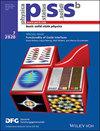热水解诱导碲化镉纳米颗粒上的 MnS 壳自组装:合成与表征
IF 1.8
4区 物理与天体物理
Q3 PHYSICS, CONDENSED MATTER
引用次数: 0
摘要
在此,我们合成了分散在水溶液中的碲化镉/锰锌核/壳纳米粒子。MnS 半导体外壳是通过自发自组装形成的。热水解可去除过量的硫醇并释放出 S2- 离子,从而激活这一过程。在此过程中,CdTe 纳米粒子表面的 Mn2+ 离子与 S2- 离子结合,产生了一层精细的 MnS 半导体层。测量结果包括拉曼光谱、光吸收和电化学测量。拉曼光谱显示了 141 和 163 cm-1 处的碲化镉特征带。221 和 444 cm-1 处的带与 MnS 结构有关。使用循环伏安法和差分脉冲伏安法估算出电化学间隙≈2.47 eV。吸收光学测量显示了树状吸收带。波长在 460 至 520 nm 之间的宽带与碲化镉纳米粒子的第一个转变有关。吸收光谱显示,所有回流样品的光隙范围都在 2.41-2.33 eV 之间。这些值与电化学测量结果一致。这些结果证明,在碲化镉纳米粒子上自发地形成了一层自组装的 MnS 纳米粒子薄层,从而形成了一种核壳半导体纳米结构。本文章由计算机程序翻译,如有差异,请以英文原文为准。
Self‐Assembly of MnS Shell on CdTe Nanoparticles Induced by Thermohydrolysis: Synthesis and Characterization
Herein, CdTe/MnS core/shell nanoparticles dispersed in an aqueous solution have been synthesized. The formation of MnS semiconductor shell occurs by spontaneous self‐assembly. This process is activated by thermal hydrolysis that removes the excess of thiol and releases S2− ions. In this process, Mn2+ ions on the surface of the CdTe nanoparticles bind to S2− ions to produce a fine semiconducting layer of MnS. Measurements of Raman spectroscopy, optical absorption, and electrochemical measurements are performed. The Raman spectrum shows CdTe characteristic bands at 141 and 163 cm−1 . Bands at 221 and 444 cm−1 are associated with the MnS structure. Cyclic voltammetry and differential pulse voltammetry are used to estimate the electrochemical gap at ≈2.47 eV. Absorption optical measurements show tree absorption bands. A broad band between 460 and 520 nm is associated with the first transition in CdTe nanoparticle. The absorption spectrum reveals an optical gap in the range of 2.41–2.33 eV for all the refluxed samples. These values are consistent with those obtained with the electrochemical measurements. The results evidence the formation of a core–shell semiconducting nanostructure made of CdTe nanoparticles coated with a spontaneously self‐assembled thin layer of MnS nanoparticles.
求助全文
通过发布文献求助,成功后即可免费获取论文全文。
去求助
来源期刊
CiteScore
3.30
自引率
6.20%
发文量
321
审稿时长
2 months
期刊介绍:
physica status solidi is devoted to the thorough peer review and the rapid publication of new and important results in all fields of solid state and materials physics, from basic science to applications and devices. Being among the largest and most important international publications, the pss journals publish review articles, letters and original work as well as special issues and conference contributions.
physica status solidi b – basic solid state physics is devoted to topics such as theoretical and experimental investigations of the atomistic and electronic structure of solids in general, phase transitions, electronic and optical properties of low-dimensional, nano-scale, strongly correlated, or disordered systems, superconductivity, magnetism, ferroelectricity etc.

 求助内容:
求助内容: 应助结果提醒方式:
应助结果提醒方式:


